BUS107 Commercial Law: Analyzing Duty of Care and Negligence Issues
VerifiedAdded on 2023/04/23
|6
|1323
|325
Homework Assignment
AI Summary
This assignment delves into several key issues within commercial law, starting with an analysis of the duty of care owed by radio hosts to a nurse following a prank call, drawing upon the 'neighbour test' from Donoghue v Stevenson. The assignment then evaluates the effectiveness of aviation regulations in Australia in preventing similar incidents to a Germanwings plane crash. It further explores the concept of causation and remoteness by examining the impact of a gesture by Trevor Huddleston on ending apartheid in South Africa. Finally, the assignment concludes by proposing two strategies, voluntary assumption of risk and contributory negligence, that AAA can implement to protect itself from negligence claims. Each issue is addressed using the IRAC method (Issue, Rule, Application, Conclusion), providing a comprehensive understanding of the legal principles and their practical application.
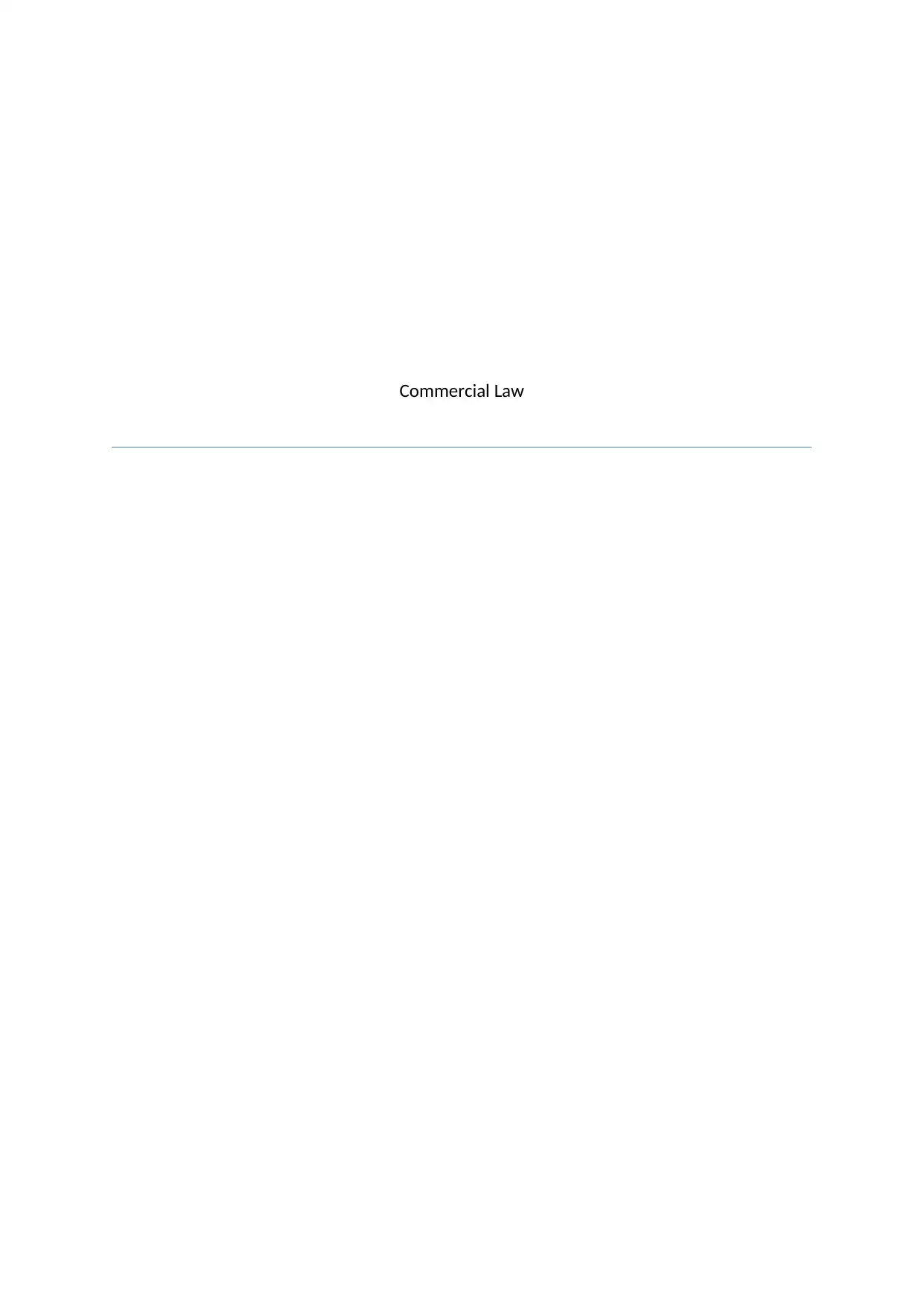
Commercial Law
Paraphrase This Document
Need a fresh take? Get an instant paraphrase of this document with our AI Paraphraser
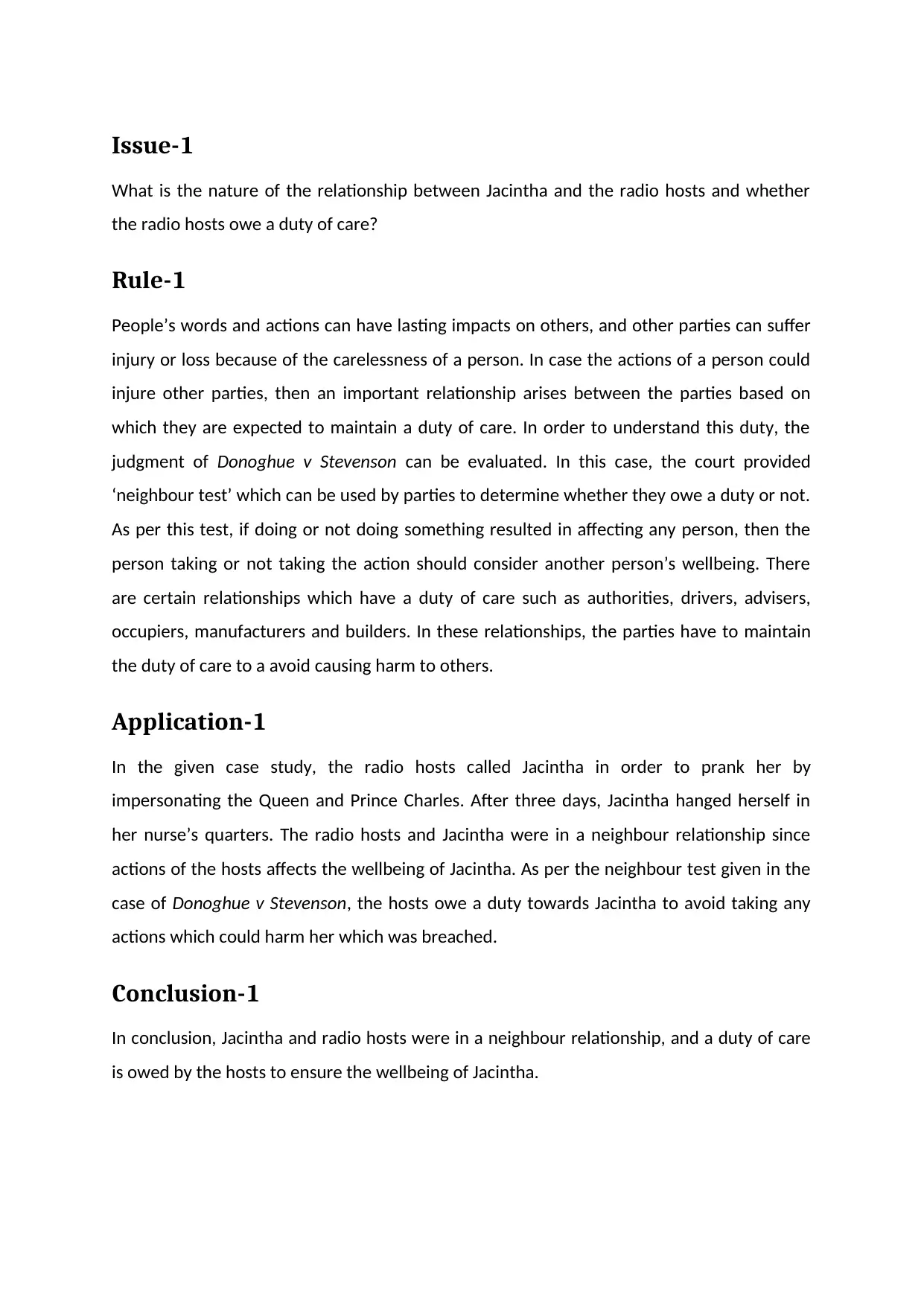
Issue-1
What is the nature of the relationship between Jacintha and the radio hosts and whether
the radio hosts owe a duty of care?
Rule-1
People’s words and actions can have lasting impacts on others, and other parties can suffer
injury or loss because of the carelessness of a person. In case the actions of a person could
injure other parties, then an important relationship arises between the parties based on
which they are expected to maintain a duty of care. In order to understand this duty, the
judgment of Donoghue v Stevenson can be evaluated. In this case, the court provided
‘neighbour test’ which can be used by parties to determine whether they owe a duty or not.
As per this test, if doing or not doing something resulted in affecting any person, then the
person taking or not taking the action should consider another person’s wellbeing. There
are certain relationships which have a duty of care such as authorities, drivers, advisers,
occupiers, manufacturers and builders. In these relationships, the parties have to maintain
the duty of care to a avoid causing harm to others.
Application-1
In the given case study, the radio hosts called Jacintha in order to prank her by
impersonating the Queen and Prince Charles. After three days, Jacintha hanged herself in
her nurse’s quarters. The radio hosts and Jacintha were in a neighbour relationship since
actions of the hosts affects the wellbeing of Jacintha. As per the neighbour test given in the
case of Donoghue v Stevenson, the hosts owe a duty towards Jacintha to avoid taking any
actions which could harm her which was breached.
Conclusion-1
In conclusion, Jacintha and radio hosts were in a neighbour relationship, and a duty of care
is owed by the hosts to ensure the wellbeing of Jacintha.
What is the nature of the relationship between Jacintha and the radio hosts and whether
the radio hosts owe a duty of care?
Rule-1
People’s words and actions can have lasting impacts on others, and other parties can suffer
injury or loss because of the carelessness of a person. In case the actions of a person could
injure other parties, then an important relationship arises between the parties based on
which they are expected to maintain a duty of care. In order to understand this duty, the
judgment of Donoghue v Stevenson can be evaluated. In this case, the court provided
‘neighbour test’ which can be used by parties to determine whether they owe a duty or not.
As per this test, if doing or not doing something resulted in affecting any person, then the
person taking or not taking the action should consider another person’s wellbeing. There
are certain relationships which have a duty of care such as authorities, drivers, advisers,
occupiers, manufacturers and builders. In these relationships, the parties have to maintain
the duty of care to a avoid causing harm to others.
Application-1
In the given case study, the radio hosts called Jacintha in order to prank her by
impersonating the Queen and Prince Charles. After three days, Jacintha hanged herself in
her nurse’s quarters. The radio hosts and Jacintha were in a neighbour relationship since
actions of the hosts affects the wellbeing of Jacintha. As per the neighbour test given in the
case of Donoghue v Stevenson, the hosts owe a duty towards Jacintha to avoid taking any
actions which could harm her which was breached.
Conclusion-1
In conclusion, Jacintha and radio hosts were in a neighbour relationship, and a duty of care
is owed by the hosts to ensure the wellbeing of Jacintha.
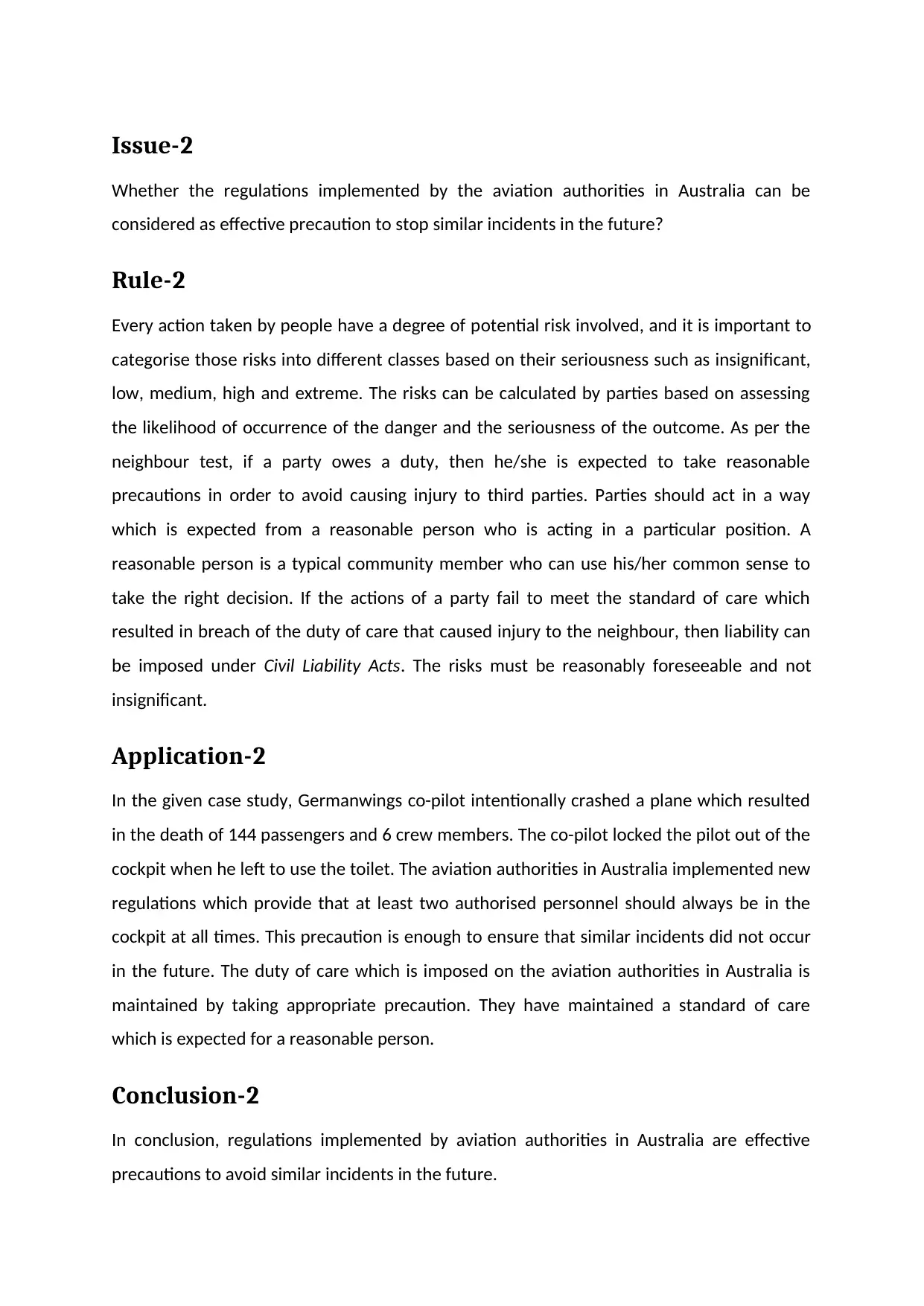
Issue-2
Whether the regulations implemented by the aviation authorities in Australia can be
considered as effective precaution to stop similar incidents in the future?
Rule-2
Every action taken by people have a degree of potential risk involved, and it is important to
categorise those risks into different classes based on their seriousness such as insignificant,
low, medium, high and extreme. The risks can be calculated by parties based on assessing
the likelihood of occurrence of the danger and the seriousness of the outcome. As per the
neighbour test, if a party owes a duty, then he/she is expected to take reasonable
precautions in order to avoid causing injury to third parties. Parties should act in a way
which is expected from a reasonable person who is acting in a particular position. A
reasonable person is a typical community member who can use his/her common sense to
take the right decision. If the actions of a party fail to meet the standard of care which
resulted in breach of the duty of care that caused injury to the neighbour, then liability can
be imposed under Civil Liability Acts. The risks must be reasonably foreseeable and not
insignificant.
Application-2
In the given case study, Germanwings co-pilot intentionally crashed a plane which resulted
in the death of 144 passengers and 6 crew members. The co-pilot locked the pilot out of the
cockpit when he left to use the toilet. The aviation authorities in Australia implemented new
regulations which provide that at least two authorised personnel should always be in the
cockpit at all times. This precaution is enough to ensure that similar incidents did not occur
in the future. The duty of care which is imposed on the aviation authorities in Australia is
maintained by taking appropriate precaution. They have maintained a standard of care
which is expected for a reasonable person.
Conclusion-2
In conclusion, regulations implemented by aviation authorities in Australia are effective
precautions to avoid similar incidents in the future.
Whether the regulations implemented by the aviation authorities in Australia can be
considered as effective precaution to stop similar incidents in the future?
Rule-2
Every action taken by people have a degree of potential risk involved, and it is important to
categorise those risks into different classes based on their seriousness such as insignificant,
low, medium, high and extreme. The risks can be calculated by parties based on assessing
the likelihood of occurrence of the danger and the seriousness of the outcome. As per the
neighbour test, if a party owes a duty, then he/she is expected to take reasonable
precautions in order to avoid causing injury to third parties. Parties should act in a way
which is expected from a reasonable person who is acting in a particular position. A
reasonable person is a typical community member who can use his/her common sense to
take the right decision. If the actions of a party fail to meet the standard of care which
resulted in breach of the duty of care that caused injury to the neighbour, then liability can
be imposed under Civil Liability Acts. The risks must be reasonably foreseeable and not
insignificant.
Application-2
In the given case study, Germanwings co-pilot intentionally crashed a plane which resulted
in the death of 144 passengers and 6 crew members. The co-pilot locked the pilot out of the
cockpit when he left to use the toilet. The aviation authorities in Australia implemented new
regulations which provide that at least two authorised personnel should always be in the
cockpit at all times. This precaution is enough to ensure that similar incidents did not occur
in the future. The duty of care which is imposed on the aviation authorities in Australia is
maintained by taking appropriate precaution. They have maintained a standard of care
which is expected for a reasonable person.
Conclusion-2
In conclusion, regulations implemented by aviation authorities in Australia are effective
precautions to avoid similar incidents in the future.
⊘ This is a preview!⊘
Do you want full access?
Subscribe today to unlock all pages.

Trusted by 1+ million students worldwide

Paraphrase This Document
Need a fresh take? Get an instant paraphrase of this document with our AI Paraphraser
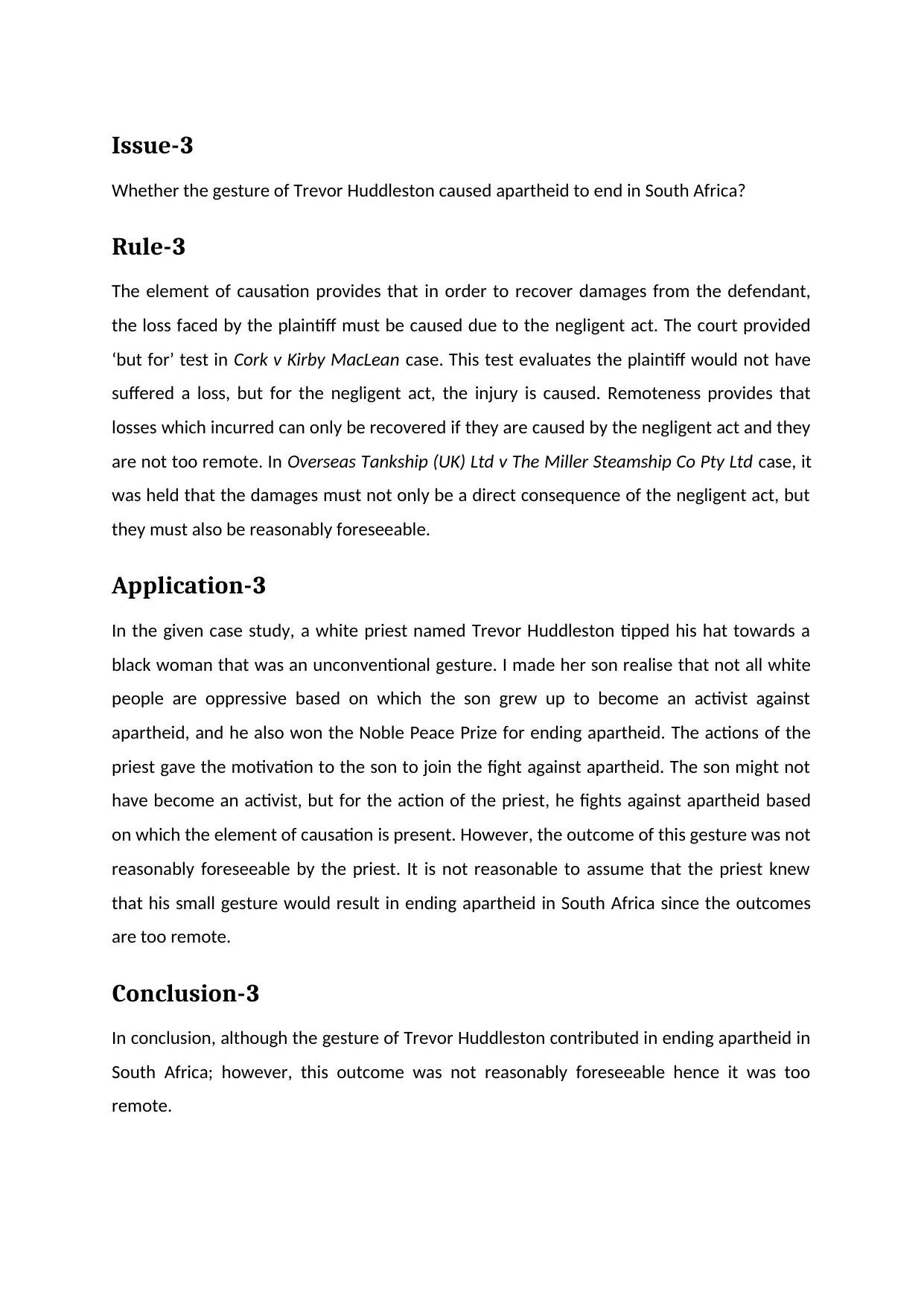
Issue-3
Whether the gesture of Trevor Huddleston caused apartheid to end in South Africa?
Rule-3
The element of causation provides that in order to recover damages from the defendant,
the loss faced by the plaintiff must be caused due to the negligent act. The court provided
‘but for’ test in Cork v Kirby MacLean case. This test evaluates the plaintiff would not have
suffered a loss, but for the negligent act, the injury is caused. Remoteness provides that
losses which incurred can only be recovered if they are caused by the negligent act and they
are not too remote. In Overseas Tankship (UK) Ltd v The Miller Steamship Co Pty Ltd case, it
was held that the damages must not only be a direct consequence of the negligent act, but
they must also be reasonably foreseeable.
Application-3
In the given case study, a white priest named Trevor Huddleston tipped his hat towards a
black woman that was an unconventional gesture. I made her son realise that not all white
people are oppressive based on which the son grew up to become an activist against
apartheid, and he also won the Noble Peace Prize for ending apartheid. The actions of the
priest gave the motivation to the son to join the fight against apartheid. The son might not
have become an activist, but for the action of the priest, he fights against apartheid based
on which the element of causation is present. However, the outcome of this gesture was not
reasonably foreseeable by the priest. It is not reasonable to assume that the priest knew
that his small gesture would result in ending apartheid in South Africa since the outcomes
are too remote.
Conclusion-3
In conclusion, although the gesture of Trevor Huddleston contributed in ending apartheid in
South Africa; however, this outcome was not reasonably foreseeable hence it was too
remote.
Whether the gesture of Trevor Huddleston caused apartheid to end in South Africa?
Rule-3
The element of causation provides that in order to recover damages from the defendant,
the loss faced by the plaintiff must be caused due to the negligent act. The court provided
‘but for’ test in Cork v Kirby MacLean case. This test evaluates the plaintiff would not have
suffered a loss, but for the negligent act, the injury is caused. Remoteness provides that
losses which incurred can only be recovered if they are caused by the negligent act and they
are not too remote. In Overseas Tankship (UK) Ltd v The Miller Steamship Co Pty Ltd case, it
was held that the damages must not only be a direct consequence of the negligent act, but
they must also be reasonably foreseeable.
Application-3
In the given case study, a white priest named Trevor Huddleston tipped his hat towards a
black woman that was an unconventional gesture. I made her son realise that not all white
people are oppressive based on which the son grew up to become an activist against
apartheid, and he also won the Noble Peace Prize for ending apartheid. The actions of the
priest gave the motivation to the son to join the fight against apartheid. The son might not
have become an activist, but for the action of the priest, he fights against apartheid based
on which the element of causation is present. However, the outcome of this gesture was not
reasonably foreseeable by the priest. It is not reasonable to assume that the priest knew
that his small gesture would result in ending apartheid in South Africa since the outcomes
are too remote.
Conclusion-3
In conclusion, although the gesture of Trevor Huddleston contributed in ending apartheid in
South Africa; however, this outcome was not reasonably foreseeable hence it was too
remote.
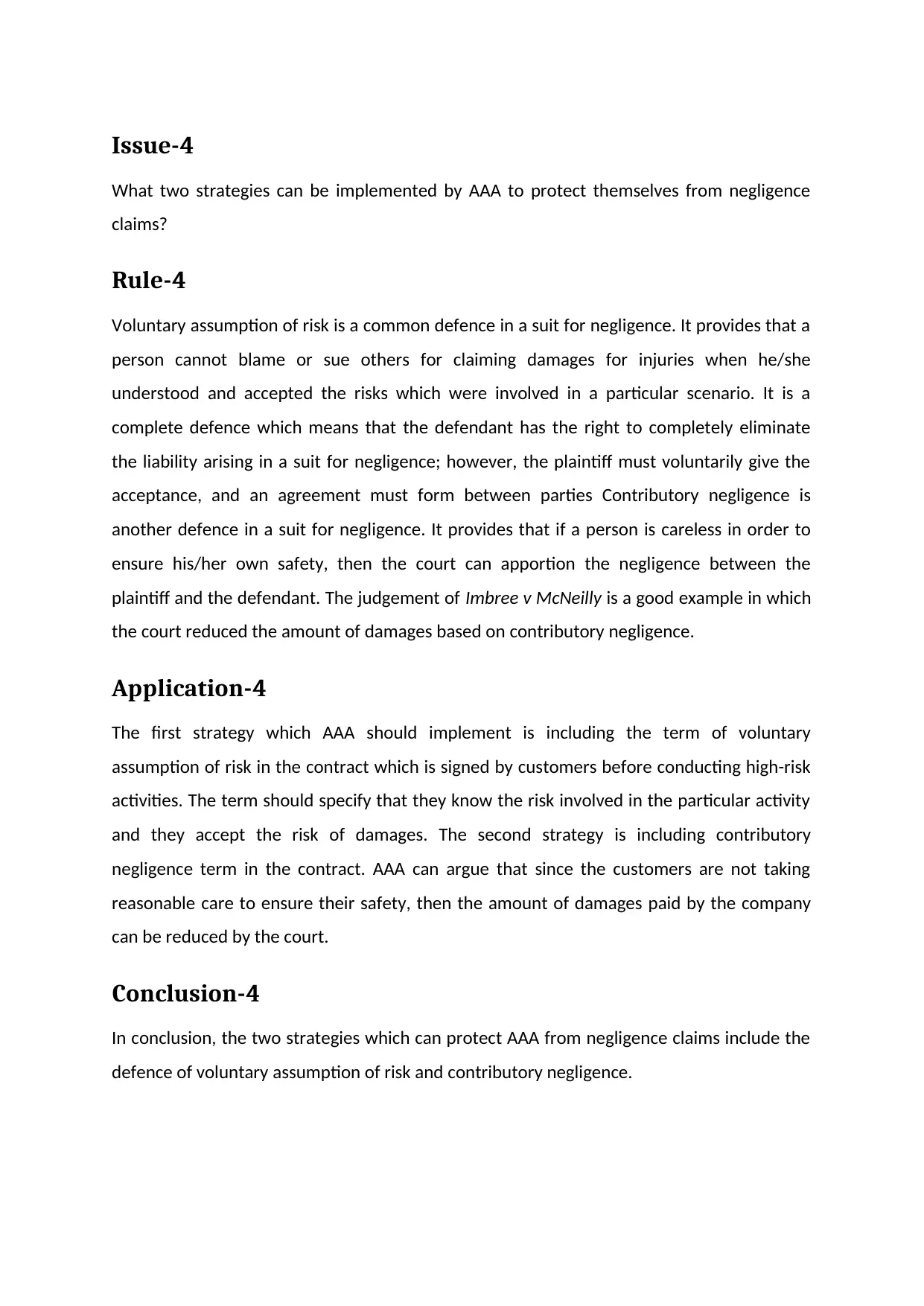
Issue-4
What two strategies can be implemented by AAA to protect themselves from negligence
claims?
Rule-4
Voluntary assumption of risk is a common defence in a suit for negligence. It provides that a
person cannot blame or sue others for claiming damages for injuries when he/she
understood and accepted the risks which were involved in a particular scenario. It is a
complete defence which means that the defendant has the right to completely eliminate
the liability arising in a suit for negligence; however, the plaintiff must voluntarily give the
acceptance, and an agreement must form between parties Contributory negligence is
another defence in a suit for negligence. It provides that if a person is careless in order to
ensure his/her own safety, then the court can apportion the negligence between the
plaintiff and the defendant. The judgement of Imbree v McNeilly is a good example in which
the court reduced the amount of damages based on contributory negligence.
Application-4
The first strategy which AAA should implement is including the term of voluntary
assumption of risk in the contract which is signed by customers before conducting high-risk
activities. The term should specify that they know the risk involved in the particular activity
and they accept the risk of damages. The second strategy is including contributory
negligence term in the contract. AAA can argue that since the customers are not taking
reasonable care to ensure their safety, then the amount of damages paid by the company
can be reduced by the court.
Conclusion-4
In conclusion, the two strategies which can protect AAA from negligence claims include the
defence of voluntary assumption of risk and contributory negligence.
What two strategies can be implemented by AAA to protect themselves from negligence
claims?
Rule-4
Voluntary assumption of risk is a common defence in a suit for negligence. It provides that a
person cannot blame or sue others for claiming damages for injuries when he/she
understood and accepted the risks which were involved in a particular scenario. It is a
complete defence which means that the defendant has the right to completely eliminate
the liability arising in a suit for negligence; however, the plaintiff must voluntarily give the
acceptance, and an agreement must form between parties Contributory negligence is
another defence in a suit for negligence. It provides that if a person is careless in order to
ensure his/her own safety, then the court can apportion the negligence between the
plaintiff and the defendant. The judgement of Imbree v McNeilly is a good example in which
the court reduced the amount of damages based on contributory negligence.
Application-4
The first strategy which AAA should implement is including the term of voluntary
assumption of risk in the contract which is signed by customers before conducting high-risk
activities. The term should specify that they know the risk involved in the particular activity
and they accept the risk of damages. The second strategy is including contributory
negligence term in the contract. AAA can argue that since the customers are not taking
reasonable care to ensure their safety, then the amount of damages paid by the company
can be reduced by the court.
Conclusion-4
In conclusion, the two strategies which can protect AAA from negligence claims include the
defence of voluntary assumption of risk and contributory negligence.
⊘ This is a preview!⊘
Do you want full access?
Subscribe today to unlock all pages.

Trusted by 1+ million students worldwide
1 out of 6
Related Documents
Your All-in-One AI-Powered Toolkit for Academic Success.
+13062052269
info@desklib.com
Available 24*7 on WhatsApp / Email
![[object Object]](/_next/static/media/star-bottom.7253800d.svg)
Unlock your academic potential
Copyright © 2020–2025 A2Z Services. All Rights Reserved. Developed and managed by ZUCOL.





